Ray T. Chen
PACE: Pacing Operator Learning to Accurate Optical Field Simulation for Complicated Photonic Devices
Nov 05, 2024



Abstract:Electromagnetic field simulation is central to designing, optimizing, and validating photonic devices and circuits. However, costly computation associated with numerical simulation poses a significant bottleneck, hindering scalability and turnaround time in the photonic circuit design process. Neural operators offer a promising alternative, but existing SOTA approaches, NeurOLight, struggle with predicting high-fidelity fields for real-world complicated photonic devices, with the best reported 0.38 normalized mean absolute error in NeurOLight. The inter-plays of highly complex light-matter interaction, e.g., scattering and resonance, sensitivity to local structure details, non-uniform learning complexity for full-domain simulation, and rich frequency information, contribute to the failure of existing neural PDE solvers. In this work, we boost the prediction fidelity to an unprecedented level for simulating complex photonic devices with a novel operator design driven by the above challenges. We propose a novel cross-axis factorized PACE operator with a strong long-distance modeling capacity to connect the full-domain complex field pattern with local device structures. Inspired by human learning, we further divide and conquer the simulation task for extremely hard cases into two progressively easy tasks, with a first-stage model learning an initial solution refined by a second model. On various complicated photonic device benchmarks, we demonstrate one sole PACE model is capable of achieving 73% lower error with 50% fewer parameters compared with various recent ML for PDE solvers. The two-stage setup further advances high-fidelity simulation for even more intricate cases. In terms of runtime, PACE demonstrates 154-577x and 11.8-12x simulation speedup over numerical solver using scipy or highly-optimized pardiso solver, respectively. We open sourced the code and dataset.
Integrated multi-operand optical neurons for scalable and hardware-efficient deep learning
May 31, 2023Abstract:The optical neural network (ONN) is a promising hardware platform for next-generation neuromorphic computing due to its high parallelism, low latency, and low energy consumption. However, previous integrated photonic tensor cores (PTCs) consume numerous single-operand optical modulators for signal and weight encoding, leading to large area costs and high propagation loss to implement large tensor operations. This work proposes a scalable and efficient optical dot-product engine based on customized multi-operand photonic devices, namely multi-operand optical neurons (MOON). We experimentally demonstrate the utility of a MOON using a multi-operand-Mach-Zehnder-interferometer (MOMZI) in image recognition tasks. Specifically, our MOMZI-based ONN achieves a measured accuracy of 85.89% in the street view house number (SVHN) recognition dataset with 4-bit voltage control precision. Furthermore, our performance analysis reveals that a 128x128 MOMZI-based PTCs outperform their counterparts based on single-operand MZIs by one to two order-of-magnitudes in propagation loss, optical delay, and total device footprint, with comparable matrix expressivity.
M3ICRO: Machine Learning-Enabled Compact Photonic Tensor Core based on PRogrammable Multi-Operand Multimode Interference
May 31, 2023Abstract:Photonic computing shows promise for transformative advancements in machine learning (ML) acceleration, offering ultra-fast speed, massive parallelism, and high energy efficiency. However, current photonic tensor core (PTC) designs based on standard optical components hinder scalability and compute density due to their large spatial footprint. To address this, we propose an ultra-compact PTC using customized programmable multi-operand multimode interference (MOMMI) devices, named M3ICRO. The programmable MOMMI leverages the intrinsic light propagation principle, providing a single-device programmable matrix unit beyond the conventional computing paradigm of one multiply-accumulate (MAC) operation per device. To overcome the optimization difficulty of customized devices that often requires time-consuming simulation, we apply ML for optics to predict the device behavior and enable a differentiable optimization flow. We thoroughly investigate the reconfigurability and matrix expressivity of our customized PTC, and introduce a novel block unfolding method to fully exploit the computing capabilities of a complex-valued PTC for near-universal real-valued linear transformations. Extensive evaluations demonstrate that M3ICRO achieves a 3.4-9.6x smaller footprint, 1.6-4.4x higher speed, 10.6-42x higher compute density, 3.7-12x higher system throughput, and superior noise robustness compared to state-of-the-art coherent PTC designs, while maintaining close-to-digital task accuracy across various ML benchmarks. Our code is open-sourced at https://github.com/JeremieMelo/M3ICRO-MOMMI.
NeurOLight: A Physics-Agnostic Neural Operator Enabling Parametric Photonic Device Simulation
Sep 19, 2022
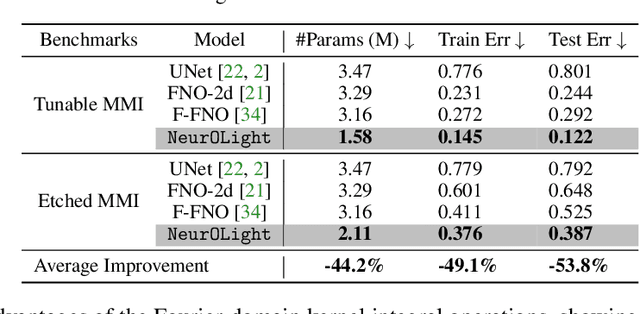

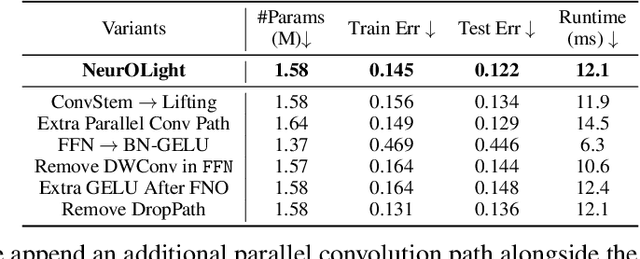
Abstract:Optical computing is an emerging technology for next-generation efficient artificial intelligence (AI) due to its ultra-high speed and efficiency. Electromagnetic field simulation is critical to the design, optimization, and validation of photonic devices and circuits. However, costly numerical simulation significantly hinders the scalability and turn-around time in the photonic circuit design loop. Recently, physics-informed neural networks have been proposed to predict the optical field solution of a single instance of a partial differential equation (PDE) with predefined parameters. Their complicated PDE formulation and lack of efficient parametrization mechanisms limit their flexibility and generalization in practical simulation scenarios. In this work, for the first time, a physics-agnostic neural operator-based framework, dubbed NeurOLight, is proposed to learn a family of frequency-domain Maxwell PDEs for ultra-fast parametric photonic device simulation. We balance the efficiency and generalization of NeurOLight via several novel techniques. Specifically, we discretize different devices into a unified domain, represent parametric PDEs with a compact wave prior, and encode the incident light via masked source modeling. We design our model with parameter-efficient cross-shaped NeurOLight blocks and adopt superposition-based augmentation for data-efficient learning. With these synergistic approaches, NeurOLight generalizes to a large space of unseen simulation settings, demonstrates 2-orders-of-magnitude faster simulation speed than numerical solvers, and outperforms prior neural network models by ~54% lower prediction error with ~44% fewer parameters. Our code is available at https://github.com/JeremieMelo/NeurOLight.
ELight: Enabling Efficient Photonic In-Memory Neurocomputing with Life Enhancement
Dec 15, 2021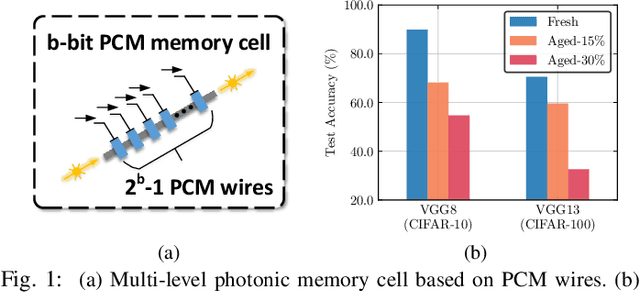
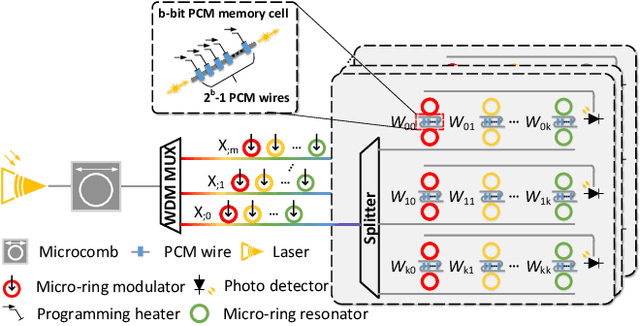
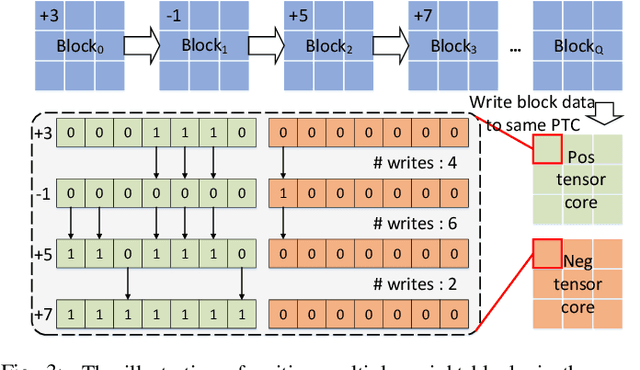
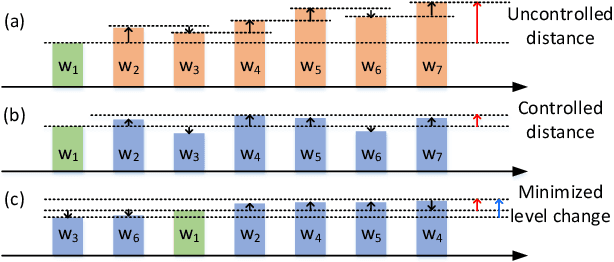
Abstract:With the recent advances in optical phase change material (PCM), photonic in-memory neurocomputing has demonstrated its superiority in optical neural network (ONN) designs with near-zero static power consumption, time-of-light latency, and compact footprint. However, photonic tensor cores require massive hardware reuse to implement large matrix multiplication due to the limited single-core scale. The resultant large number of PCM writes leads to serious dynamic power and overwhelms the fragile PCM with limited write endurance. In this work, we propose a synergistic optimization framework, ELight, to minimize the overall write efforts for efficient and reliable optical in-memory neurocomputing. We first propose write-aware training to encourage the similarity among weight blocks, and combine it with a post-training optimization method to reduce programming efforts by eliminating redundant writes. Experiments show that ELight can achieve over 20X reduction in the total number of writes and dynamic power with comparable accuracy. With our ELight, photonic in-memory neurocomputing will step forward towards viable applications in machine learning with preserved accuracy, order-of-magnitude longer lifetime, and lower programming energy.
Silicon photonic subspace neural chip for hardware-efficient deep learning
Nov 11, 2021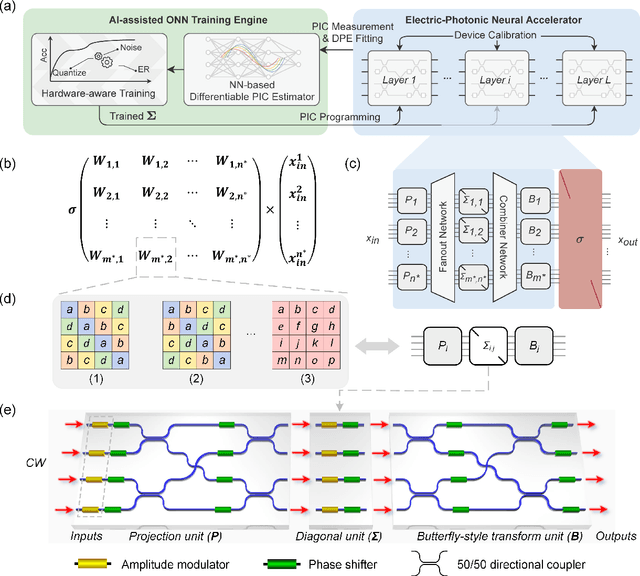
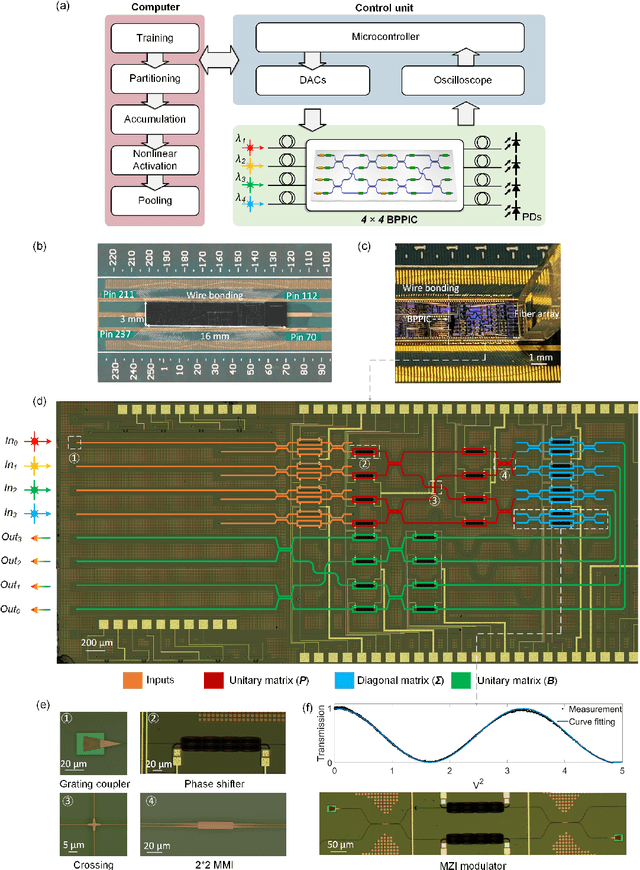
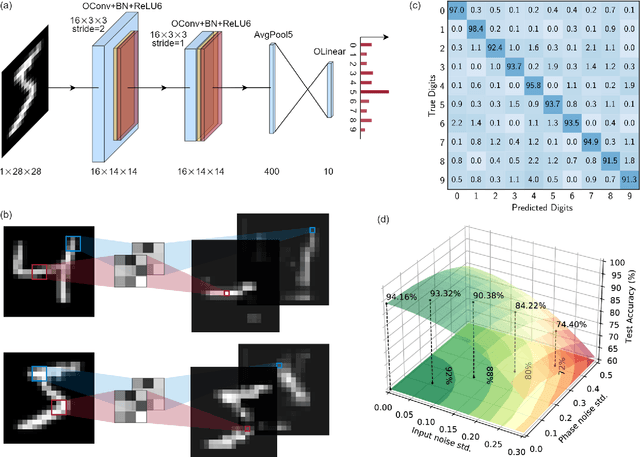
Abstract:As deep learning has shown revolutionary performance in many artificial intelligence applications, its escalating computation demand requires hardware accelerators for massive parallelism and improved throughput. The optical neural network (ONN) is a promising candidate for next-generation neurocomputing due to its high parallelism, low latency, and low energy consumption. Here, we devise a hardware-efficient photonic subspace neural network (PSNN) architecture, which targets lower optical component usage, area cost, and energy consumption than previous ONN architectures with comparable task performance. Additionally, a hardware-aware training framework is provided to minimize the required device programming precision, lessen the chip area, and boost the noise robustness. We experimentally demonstrate our PSNN on a butterfly-style programmable silicon photonic integrated circuit and show its utility in practical image recognition tasks.
L2ight: Enabling On-Chip Learning for Optical Neural Networks via Efficient in-situ Subspace Optimization
Oct 27, 2021



Abstract:Silicon-photonics-based optical neural network (ONN) is a promising hardware platform that could represent a paradigm shift in efficient AI with its CMOS-compatibility, flexibility, ultra-low execution latency, and high energy efficiency. In-situ training on the online programmable photonic chips is appealing but still encounters challenging issues in on-chip implementability, scalability, and efficiency. In this work, we propose a closed-loop ONN on-chip learning framework L2ight to enable scalable ONN mapping and efficient in-situ learning. L2ight adopts a three-stage learning flow that first calibrates the complicated photonic circuit states under challenging physical constraints, then performs photonic core mapping via combined analytical solving and zeroth-order optimization. A subspace learning procedure with multi-level sparsity is integrated into L2ight to enable in-situ gradient evaluation and fast adaptation, unleashing the power of optics for real on-chip intelligence. Extensive experiments demonstrate our proposed L2ight outperforms prior ONN training protocols with 3-order-of-magnitude higher scalability and over 30X better efficiency, when benchmarked on various models and learning tasks. This synergistic framework is the first scalable on-chip learning solution that pushes this emerging field from intractable to scalable and further to efficient for next-generation self-learnable photonic neural chips. From a co-design perspective, L2ight also provides essential insights for hardware-restricted unitary subspace optimization and efficient sparse training. We open-source our framework at https://github.com/JeremieMelo/L2ight.
Towards Memory-Efficient Neural Networks via Multi-Level in situ Generation
Sep 05, 2021



Abstract:Deep neural networks (DNN) have shown superior performance in a variety of tasks. As they rapidly evolve, their escalating computation and memory demands make it challenging to deploy them on resource-constrained edge devices. Though extensive efficient accelerator designs, from traditional electronics to emerging photonics, have been successfully demonstrated, they are still bottlenecked by expensive memory accesses due to tremendous gaps between the bandwidth/power/latency of electrical memory and computing cores. Previous solutions fail to fully-leverage the ultra-fast computational speed of emerging DNN accelerators to break through the critical memory bound. In this work, we propose a general and unified framework to trade expensive memory transactions with ultra-fast on-chip computations, directly translating to performance improvement. We are the first to jointly explore the intrinsic correlations and bit-level redundancy within DNN kernels and propose a multi-level in situ generation mechanism with mixed-precision bases to achieve on-the-fly recovery of high-resolution parameters with minimum hardware overhead. Extensive experiments demonstrate that our proposed joint method can boost the memory efficiency by 10-20x with comparable accuracy over four state-of-the-art designs, when benchmarked on ResNet-18/DenseNet-121/MobileNetV2/V3 with various tasks.
Efficient On-Chip Learning for Optical Neural Networks Through Power-Aware Sparse Zeroth-Order Optimization
Dec 21, 2020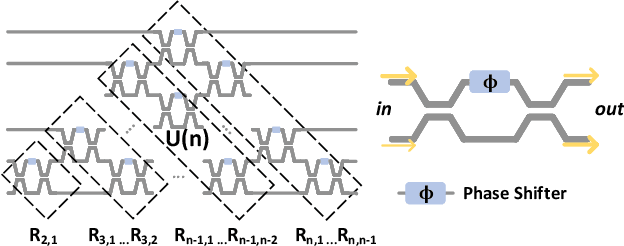
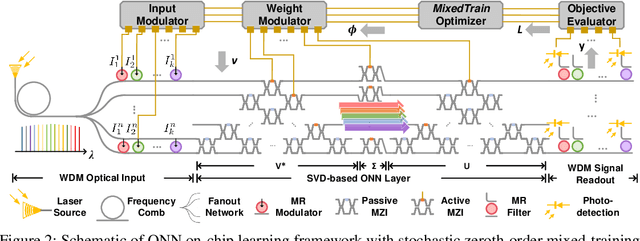


Abstract:Optical neural networks (ONNs) have demonstrated record-breaking potential in high-performance neuromorphic computing due to their ultra-high execution speed and low energy consumption. However, current learning protocols fail to provide scalable and efficient solutions to photonic circuit optimization in practical applications. In this work, we propose a novel on-chip learning framework to release the full potential of ONNs for power-efficient in situ training. Instead of deploying implementation-costly back-propagation, we directly optimize the device configurations with computation budgets and power constraints. We are the first to model the ONN on-chip learning as a resource-constrained stochastic noisy zeroth-order optimization problem, and propose a novel mixed-training strategy with two-level sparsity and power-aware dynamic pruning to offer a scalable on-chip training solution in practical ONN deployment. Compared with previous methods, we are the first to optimize over 2,500 optical components on chip. We can achieve much better optimization stability, 3.7x-7.6x higher efficiency, and save >90% power under practical device variations and thermal crosstalk.
 Add to Chrome
Add to Chrome Add to Firefox
Add to Firefox Add to Edge
Add to Edge